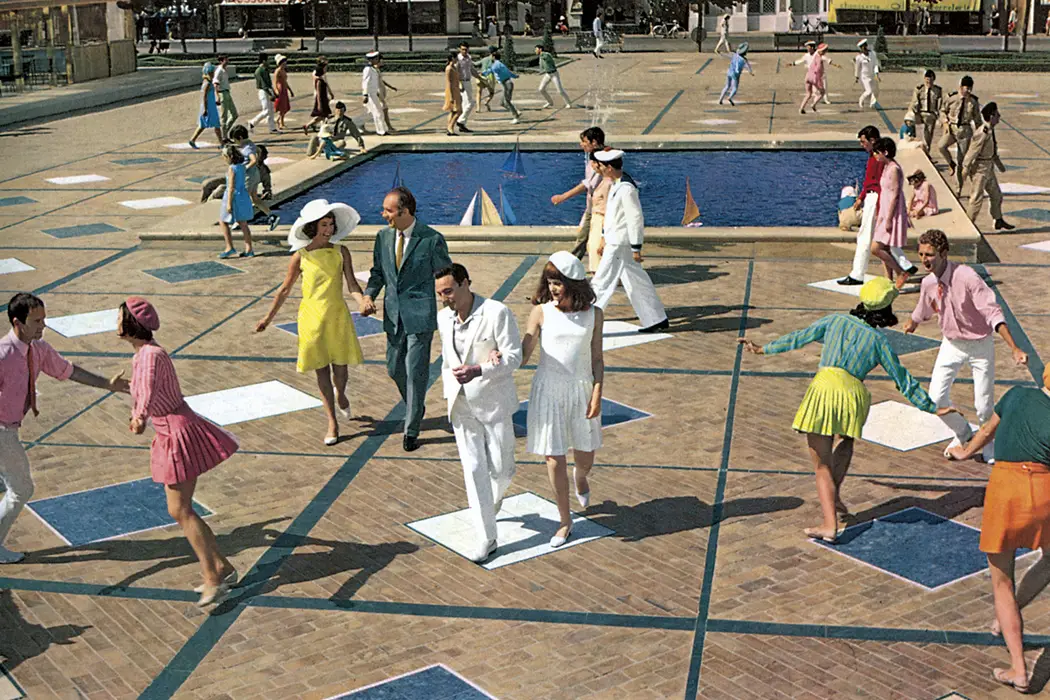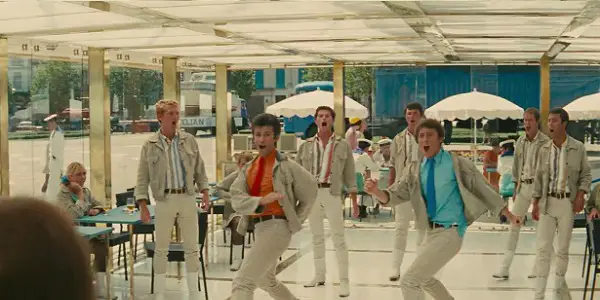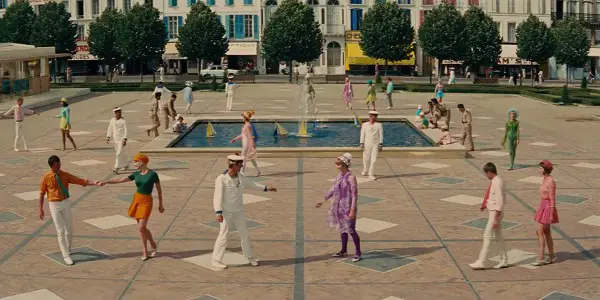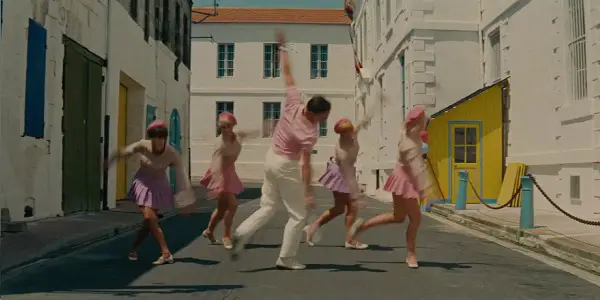THE YOUNG GIRLS OF ROCHEFORT: Where We Meet Music

Ben is a former student of cognitive science who is…
La La Land was one of last year’s big hits, and if you’ve read much about it, you’ve probably heard Jacques Demy cited as an influence. And he should be – not for nothing does the word “parapluies” appear near the place where La La Land‘s main character works, a direct shout-out to the French title of Demy‘s The Umbrellas of Cherbourg.
Of course, it would be a mistake to put too much emphasis on him when La La Land draws on plenty of other influences, including various strains of American musical, Nicholas Ray, Powell and Pressburger, and maybe even Alfred Hitchc*ck. Even so, I wouldn’t pass up an excuse to recommend what is, for my money, one of the greatest films of the 1960s: The Young Girls of Rochefort.
At first glance, this film might seem too weightless to earn such high praise. It takes place over a few days in the south of France, and follows various characters (most of whom are artists) around the city of Rochefort as they pursue their passions. None of them come up against any major obstacles or learn any life lessons; even when it seems like they face difficult decisions, we quickly find they already know what they want.
But the film needs no more conflict than its characters’ pursuit of art. It uses expressive colors and subtle delineations between spaces to turn the world into an instrument of expression for its characters, much like The Umbrellas of Cherbourg and 1982’s Une Chambre en Ville. What’s more, its setting is fully populated with people who seem to move about freely, giving it the gravity of a living community. And then there’s its most subtle trick: the fact that the plot’s apparent lack of conflict stems from its characters’ near-foolhardy determination.
The Artists’ Dance
The Young Girls of Rochefort‘s plot consists almost entirely of coincidental encounters between the various characters. There are the twins Solange (Françoise Dorléac) and Delphine Garnier (Catherine Deneuve), a composer and a dancer respectively. There’s also their mother Yvonne (Danielle Darrieux) and her former lover, a music shop owner named Simon Dame (Michel Piccoli) (neither of whom knows the other is also in Rochefort). Solange and Delphine long to find their soulmates, but since neither of them has met anyone lately, they’re committed to their art, and plan to move to Paris where they can really flourish. While they stick to working on their art, we see that two other romantic souls have recently arrived in Rochefort: a young painter (who’s also a sailor) named Maxence (Jacques Perrin), and a renowned American composer named Andy Miller (Gene Kelly).
It takes place over the course of a few days, starting from the day the fair arrives in town and ending when the fair packs up and leaves. The fair brings two more of the film’s main characters into Rochefort: the carnies Bill (Grover Dale) and Etienne (George Chakiris), who quickly befriend Yvonne and encounter Solange and Delphine soon after.

The film sets us up to expect a romance between Delphine and Maxence, as well as one between Solange and Andy. We also have to wonder if Yvonne and Simon will ever meet again after so many years of pining after each other. And yet, even as the characters’ passions and responsibilities send them traveling all over Rochefort, none of them ever meets the person we expect and hope for them to meet. By sheer coincidence, Delphine always misses meeting Maxence (sometimes just barely). So does Solange miss meeting Andy, and Yvonne miss meeting Simon.
On one level, it’s funny to watch them bounce around the city and never meet the one person we feel they’re supposed to meet. On another level, it keeps us in a constant state of tension, expecting romance but never getting it. Eventually we start asking ourselves questions: What if they end up with someone else? What if they finally meet the person the film sets them up with, but it doesn’t work out? What’s even going to happen if they do meet?
With Yvonne and Simon, this might even come across as tragic: here are two people who were madly in love, but split up in their youth over something silly. Now they’re more mature, and fortune has placed them both in the same town again. But they’re both stuck in one place working all day; what if they never see each other again, despite being so close?
Whether you’re laughing or tearing your hair out, The Young Girls of Rochefort does give us a hint of order and direction. The artist characters – Solange, Delphine, Maxence, and Andy – are all led by their artistic pursuits to the same destination: Paris. This collective attempt to leave Rochefort for Paris causes many of the encounters in the film. The need to fulfill artistic passions brings people together.
It would be nice to think that passion for expression can bring people together, even when fate seems determined to keep them apart. And maybe it would be nice if The Young Girls of Rochefort would simply let us believe it, if only for the two hours the film lasts. But it doesn’t let us off so easily.
Pastel Life
The Young Girls of Rochefort has a pervasive “off-ness” about it; that is, you can sense that all its most wondrous bits involve some degree of divorce from reality. The entire film is joyful; however, when everything in the film, good and bad, is taken to an elevated extreme, it seems almost desperately joyful. It’s as if it were trying to believe in something that might be beyond hope.
Consider how the film kicks off the romance between Delphine and Maxence: before they ever meet, Maxence paints his ideal woman as he imagines her, and it just so happens to be Delphine’s exact likeness; later, Delphine finds the painting in an art gallery and wonders who the mysterious artist could be that managed to envision her with such accuracy. This bit of magical realism impresses on the viewer the immense potential that could be realized in their romance. After all, if Maxence could conjure up Delphine in his imagination without ever seeing her, they must be perfect for each other, right?
This is just one of many fanciful touches in the film. Its white backgrounds and bright lighting make its colors glow, while the pastel palette keeps them from being overstimulating. It employs symmetrical compositions, and characters will often appear to directly address the camera. Characters in the background can often be seen dancing, and sometimes they’ll spontaneously add accents to the main characters’ musical numbers. Some people in Rochefort are dressed normally, others wear monochromatic costumes decorated with streaming ribbons.

Contrary to these confectionary elements are dark subplots, a military presence in Rochefort, unexpected gunshots, and the film’s aforementioned way of keeping soulmates apart. In fact, after making the fantastical suggestion that Delphine and Maxence belong together, The Young Girls of Rochefort goes on to keep them apart even more ruthlessly than it does the other couples.
All this unreality complicates the film’s treatment of artistic passion. In the end, it’s not suggesting that passionate expression brings people together; rather, it’s fantasizing about that idea, hoping for such a thing to happen. And in doing so, it expresses genuine awe and gratitude for people’s willingness to participate in art, both as creators and as spectators. The dancing in the film is noticeably imperfect, but it works, because conscious expression is so often imperfect. It stares the possibility of failure in the face and responds with something motivating, while serving equally well as a melancholic tribute to anyone who ever experienced a failure of communication because they refused to betray themselves.
Reaching Across Borders
In a way, the film itself exemplifies the will to take action and accept the burden of any response. When it was released in 1967, segments of the French population (most notably certain supporters of Charles de Gaulle) held that American culture was contaminated by consumerism, and lesser in spiritual value compared to traditional French culture. Some took that to the conclusion that the purity of French culture needed to be protected from foreign influence.
The Young Girls of Rochefort definitively chooses a side on this issue. When Gene Kelly appears on the screen and graces us with a tap dance number – the best-choreographed number in the film – it becomes clear that this film welcomes American art and has no compunctions about mixing it with French art.

This is in keeping with the film’s appreciation for shared participation in art, and with its characters’ desire to leave Rochefort and explore the world outside. As it happens, there’s another musical number performed by two other American actors, George Chakiris and Grover Dale: “Nous voyageons de ville en ville (Our trips from town to town)”. Its lyrics discuss travel as a mode of living, constant movement as a search for satisfaction.
To Conclude
As much as The Young Girls of Rochefort offers you to unpack, it’s something you can very easily watch without feeling any weight on your shoulders. Its affection for the viewer makes it perfect as breezy entertainment. It exists to live out a temporary fantasy, but sneakily refuses to let harder bits of reality out of its peripheral vision. The ingenuity with which it goes about that takes it beyond escapism and turns it into something that gives you energy.
For The Young Girls of Rochefort, all the world’s a stage, but men and women aren’t merely players. They’re players and spectators, sharing in conscious expression – expression like the dancing in this film, so often studded with little imperfections but still demonstrating deliberation, and a response to musical rhythms. For this film, failed expression (and expression is everything) is a shame, but only because success is so miraculous. Sometimes the best films acknowledge failures in the world, but only with the utmost subtlety, to the point where you can barely notice them; at the same time, with no subtlety at all, they sing about success. And given its historical context, you could even say The Young Girls of Rochefort is itself an act in its own spirit.
Does fantasy ever help you to stay motivated?
The Young Girls of Rochefort is available for streaming on Filmstruck, as is The Young Girls Turn 25, a documentary celebrating the film’s 25th anniversary. It is also available for home viewing from the Criterion Collection with the Essential Jacques Demy collection.
https://youtu.be/vZFK8svwtxA
Does content like this matter to you?
Become a Member and support film journalism. Unlock access to all of Film Inquiry`s great articles. Join a community of like-minded readers who are passionate about cinema - get access to our private members Network, give back to independent filmmakers, and more.
Ben is a former student of cognitive science who is currently trying to improve his writing style and ability to understand and appreciate films containing unfamiliar perspectives. He tries not to hold films to a strict set of criteria, but does believe that strong movies can change your outlook on the world. His favorite films include Whisper of the Heart, Hellzapoppin', Foolish Wives, 42nd Street, and the work of Charlie Chaplin.













